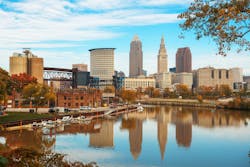Growing up in Cleveland, Ohio, you learn early everything that put the city on the map. Two local cartoonists, Jerry Siegel and Joe Shuster, gave the world Superman. The city pioneered traffic safety with the world's first electric signal in 1914, forever changing how streets operate. The Rock and Roll Hall of Fame calls Cleveland home, as does the house from "A Christmas Story," where the warning "You'll shoot your eye out" is synonymous with Red Ryder BB guns. And yes, our river caught fire — more than once.
On June 22, 1969, oil and debris on the Cuyahoga River ignited. Cleveland's Bureau of Industrial Wastes concluded the fire likely started when volatile petroleum derivatives with a low flash point were discharged into the water.
It wasn’t the first time the river caught fire, either. The first of more than a dozen fires happened in 1868. The costliest was in 1952 when an oil slick burned, causing over $1 million in damages.
Pollution is nothing new. It’s been an issue since the first humans roamed the earth, and it snowballed from there. The Industrial Revolution, complete with its chemicals and wastes, including sulfuric acid, soda ash, muriatic acid, limes, dyes, wood pulp and animal byproducts from mills, contaminated waters well before that first Cuyahoga river blaze.
But it wasn’t until the 1969 fire that the public started voicing concern across the nation. That fire truly was the catalyst that helped launch the Clean Water Act, the Great Lakes Water Quality Agreement, and the creation of the U.S. Environmental Protection Agency and the Ohio Environmental Protection Agency.
One year later, in 1970, 20 million Americans demonstrated against the prevalent attitude of ignoring or downplaying environmental issues. And so was born Earth Day.
Over the last 55 years, the world has gotten involved, and now over 1 billion people gather each April 22 to champion sustainability for the planet.
Related Reading: Regulation, Sustainability and the Shifting Role of EPA
-
Scientific Battle Between EPA and ACC Enters New Phase Under Trump
-
Rethinking Environmental Governance in the Age of Deregulation
-
Together for Sustainability Sharpens Its Carbon Math
-
Chemical Regulations: 2025’s Fuzzy Forecast
-
Regulatory Confusion Threatens Advanced Plastics Recycling Growth
-
EPA Administrator Macintosh: Regulatory Overhaul in the Works
-
EPA’s Zeldin Addresses State Environmental Agency Heads
But this year, things are different, at least in the United States.
Earlier this month, Executive Editor Jonathan Katz attended the American Chemistry Council’s annual GlobalChem conference in Washington, D.C. He reported that the EPA “plans to reform all regulations, including several that directly impact the chemical sector.”
Katz listened as Chad McIntosh, EPA's acting deputy administrator, “rattled off more than a dozen rules the agency will overhaul, including easing regulations on coal-fired power plants, air toxins, greenhouse gas reporting rules and particulate matter limits.”
And in this month’s Compliance Advisor column Lynn Bergeson also discussed the EPA’s significant actions resulting in the “biggest deregulatory” measure ever, according to EPA. The rollbacks include reconsideration of regulations on power plants, the oil and gas industry, greenhouse gas reporting, wastewater regulations and more.
Bergeson predicted much of this in her January column, Chemical Regulations: 2025’s Fuzzy Forecast.
“How the new world order is likely to evolve also is unclear. At the least, here in the United States the double whammy of Loper Bright, the blockbuster Supreme Court decision overturning the long-standing doctrine of “Chevron deference,” and a hardened resolve of the environmental non-governmental organization (eNGO) community to challenge judicial attempts to dismantle the Biden-Harris climate gains suggest a great deal of litigation is in our future.”
She ended that tarot session with “One fact remains constant. Relentless monitoring, engagement and advocacy are essential. Entities that are publicly committed to sustainability, reversing climate change and a more equitable social ordering will need to maintain those commitments regardless of new political leadership.”
Katz pointed out a similar sentiment from GlobalChem, highlighting direction from a chemical sector attorney who said that plastics recyclers should maintain their environmental safety protocols despite the Trump administration's elimination of EPA environmental justice programs.
“The federal government is not the sole arbiter of what is ESG policy,” said Brittany Bolen, a former administrator for the EPA’s Office of Policy and partner with Sidley Austin LLP.
The EU still has corporate reporting standards that producers must comply with, she said.
A review of shareholder notes, earnings reports, news releases and public filings proves that chemical industry players are still pledging environmental stewardship.
“One of the biggest challenges — and opportunities — we face in the chemical industry is acknowledging that while we can’t eliminate chemical use entirely, we can control how much we use, how we contain it and how we minimize environmental exposure,” said Mukesh Jani, environmental professional and advocate – Torrent Laboratory, in an email to Chemical Processing. “For example, through technological innovation, we’ve reduced our lab's chemical use to just 1/20th of what it once was. That’s not just a number — it’s a vision for the future.”
Jani noted that as an environmental professional, Earth Day serves as a reflection point. “On a personal level, my Earth Day commitment grew during the COVID-19 pandemic. I started a small garden in 2020, and what began as a therapeutic escape quickly became a passion project. In 2021, I planted 800 plants. The following year, I added another 500. My goal? To plant up to 10,000 plants. For me, it’s a living, growing symbol of restoration and the tangible impact each of us can have.”
As for the future, “I believe the chemical industry will be transformed by green initiatives rooted in smart technology, efficient reuse systems and stronger regulatory frameworks,” he said. “We’ll still use chemicals, but we’ll do so with precision, responsibility and purpose. Earth Day reminds us that sustainability isn’t a finish line — it’s an evolving commitment. And I’m proud to be part of that journey.”
Chris Jeffery, global executive vice president of chemical and monitoring solutions at Veolia Water Technologies & Solutions, cited his commitment to sustainability as part of the company’s guiding principle.
“This framework moves beyond traditional financial metrics to holistically evaluate our success, with environmental stewardship being a core pillar,” he told Chemical Processing. “This means that in my role, sustainability isn't just a side project; it's a fundamental lens through which we assess our value and impact across the organization.”
He explained that the company has made a “shift in how it demonstrates its worth to clients by moving away from solely focusing on financial savings – while still important – to accurately measure our solutions' tangible environmental benefits, including water, energy, waste, and associated greenhouse gas savings.”
This Earth Day, I am focusing on 55 years of progress on Cleveland’s waterways, which have come a long way since the days when local reporters described the Cuyahoga River as the river that “oozes rather than flows” and in which a person “does not drown but decays.”
I’m also counting on Jani’s vision of the future of chemicals – used with precision, responsibility and purpose. After all, the chemical industry is the mother of all industries, and she can lead by example.
About the Author
Traci Purdum
Editor-in-Chief
Traci Purdum, an award-winning business journalist with extensive experience covering manufacturing and management issues, is a graduate of the Kent State University School of Journalism and Mass Communication, Kent, Ohio, and an alumnus of the Wharton Seminar for Business Journalists, Wharton School of Business, University of Pennsylvania, Philadelphia.



